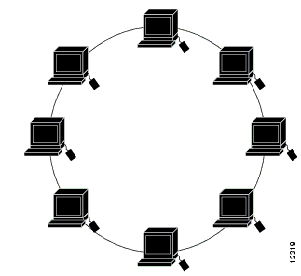Back
Home
LAN
- A
LAN
is a high-speed, fault-tolerant data network that covers a relatively small
geographic area. It
typically connects workstations, personal computers, printers, and other
devices. LANs offer
computer users many advantages, including shared access to devices and
applications, file exchange
between connected users, and communication between users via electronic mail
and other
applications.
-
- AN Protocols and the OSI
Reference Model
LAN protocols function at the lowest two layers of the OSI reference model,
between the physical layer and the data link layer.- Figure
illustrates how several popular LAN protocols map to the OSI reference model.
Popular LAN protocols mapped to the OSI reference model.

-
- LAN Media-Access Methods
LAN protocols typically use one of two methods to access the physical network
medium: carrier
sense multiple access collision detect (CSMA/CD) and token passing.
In the CSMA/CD media-access scheme, network devices contend for use of the
physical network
medium. CSMA/CD is therefore sometimes called contention access. Examples of
LANs that use
the CSMA/CD media-access scheme are Ethernet/IEEE 802.3 networks, including
100BaseT.
In the token-passing media-access scheme, network devices access the physical
medium based on
possession of a token. Examples of LANs that use the token-passing
media-access scheme are Token
Ring/IEEE 802.5 and FDDI.-
- LAN Transmission Methods
LAN data transmissions fall into three classifications: unicast, multicast,
and broadcast. In each type
of transmission, a single packet is sent to one or more nodes.
In a unicast
transmission, a single packet is sent from the source to a destination on a
network. First,
the source node addresses the packet by using the address of the destination
node. The package is
then sent onto the network, and finally, the network passes the packet to its
destination.
A multicast
transmission consists of a
single data packet that is copied and sent to a specific subset
of nodes on the network. First, the source node addresses the packet by using
a multicast address.
The packet is then sent into the network, which makes copies of the packet and
sends a copy to each
node that is part of the multicast address.-
- A
broadcast
transmission consists of a
single data packet that is copied and sent to all nodes on the
network. In these types of transmissions, the source node addresses the packet
by using the broadcast
address. The packet is then sent into the network, which makes copies of the
packet and sends a copy
to every node on the network.
-
- LAN topologies
-
- LAN topologies define the
manner in which network devices are organized. Four common LAN
topologies exist: bus, ring, star, and tree. These topologies are logical
architectures, but the actual
devices need not be physically organized in these configurations. Logical bus
and ring topologies,
for example, are commonly organized physically as a star. A bus topology is a
linear LAN
architecture in which transmissions from network stations propagate the length
of the medium and
are received by all other stations. Of the three most widely used LAN
implementations,
Ethernet/IEEE 802.3 networks--- , including 100BaseT---, implement a bus
topology.
-
- A ring topology is a LAN
architecture that consists of a series of devices connected to one another
by unidirectional transmission links to form a single closed loop. Both Token
Ring/IEEE 802.5 and
FDDI networks implement a ring topology.
A star topology is a LAN architecture in which the endpoints on a network are
connected to a
common central hub, or switch, by dedicated links. Logical bus and ring
topologies are often
implemented physically in a star topology.
A tree topology is a LAN architecture that is identical to the bus topology,
except that branches with
multiple nodes are possible in this case. Figure 2-5 illustrates a logical
tree topology.
Figure 2-4 Some networks implement a logical ring topology.
Ring topology

Tree topology 
- LAN Devices
Devices commonly used in LANs include repeaters, hubs, LAN extenders, bridges,
LAN switches,
and routers.
A repeater is a physical layer device used to interconnect the media segments
of an extended
network. A repeater essentially enables a series of cable segments to be
treated as a single cable.
Repeaters receive signals from one network segment and amplify, retime, and
retransmit those
signals to another network segment. -
- These actions prevent signal
deterioration caused by long cable
lengths and large numbers of connected devices. Repeaters are incapable of
performing complex
filtering and other traffic processing. In addition, all electrical signals,
including electrical
disturbances and other errors, are repeated and amplified. The total number of
repeaters and network
segments that can be connected is limited due to timing and other issues.
Figure illustrates a
repeater connecting two network segments.
A repeater connects two network segments

- A hub is a physical-layer
device that connects multiple user stations, each via a dedicated cable.
Electrical interconnections are established inside the hub. Hubs are used to
create a physical star
network while maintaining the logical bus or ring configuration of the LAN. In
some respects, a hub
functions as a multiport repeater.
A LAN extender is a remote-access multilayer switch that connects to a host
router. LAN extenders
forward traffic from all the standard network-layer protocols (such as IP, IPX,
and AppleTalk), and
filter traffic based on the MAC address or network-layer protocol type. LAN
extenders scale well
because the host router filters out unwanted broadcasts and multicasts. LAN
extenders, however, are
not capable of segmenting traffic or creating security firewalls. Figure
illustrates multiple LAN
extenders connected to the host router through a WAN.
-
-
Multiple LAN extenders can connect to the host router through a WAN

Back
Home





